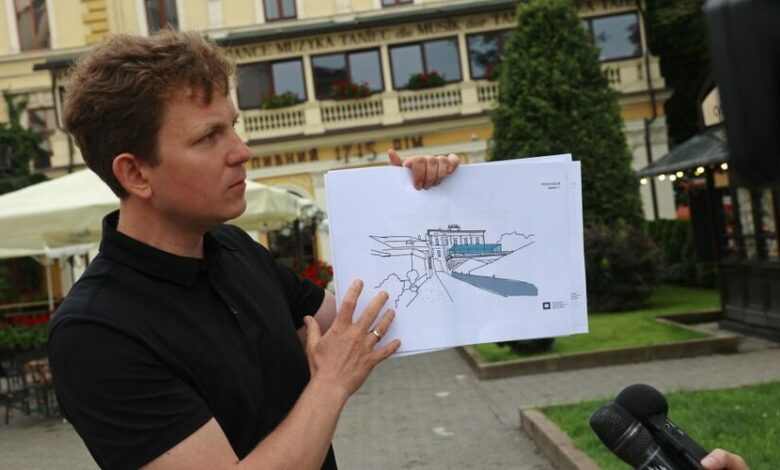
The Lviv City Council strongly urges the owner of the “Vienna Coffee House” to dismantle the extension of the summer terrace and to work together on the concept of restoring the historical appearance of the architectural monument building. Also, the chief architect of the city, Anton Kolomeytsev, presented examples of architectural solutions for similar summer terraces in European countries and visualizations of what this terrace could look like.
We will remind you that previously “Vienna Coffee House” was located on Ave. Svobody, 12, the city allowed to build a summer terrace. Later, the owner glazed it and actually made it a full-fledged annex in the monument of cultural heritage. Back in 2021, the Department of Historic Environment Protection issued an order to dismantle the terrace’s double-glazed windows. The owners challenged the order, won the first instance in court and the appeal. However, the Supreme Court sided with the city in this case.
Today, at the briefing, the chief architect of Lviv, Anton Kolomeytsev, emphasized the fact that the illegally constructed superstructure distorts the appearance of the entire monument.
“Svobody Avenue – the former Hetman’s Ramparts. And the building where the “Vienna Coffee Shop” is located was traditionally used as a coffee shop. Here since the 19th century. styles and interior arrangements were changing, but we did not expect that on the terrace of this historic coffee shop, in the heart of the city, next to the Shevchenko monument, a monster would grow – a superstructure with plastic windows, of a very strange height with an incomprehensible covering and metal corrugated flooring on the roof. Such a decision would be strange even for the periphery, not to mention the historical part of the city and the historical monument.
This add-on did not have any approvals. We see that the owner made walls, built structures on the balustrades and distorted the facade. It is, of course, asymmetrical in its composition, but the load on this second floor is absolutely opaque. We simply cannot see the building in the complex, as the architect intended it,” noted Anton Kolomeytsev.
As Nataliya Alekseeva, head of affairs of the executive committee of the city council, said, the city has repeatedly called on the owner to settle this issue peacefully. Even last year, the executive committee decided to develop a concept for restoring the historical appearance of the building. However, despite the fact that the city received a letter from the owner with assurances that relevant sketches and proposals are being developed, no sketch has been officially submitted from him yet.
“This is the 3rd year that we legally want to solve the issue of illegal additions to the terrace of the “Vienna Coffee House”. The terrace is arranged close to the architectural monument, without any permission, without any conclusion of the Lviv City Council and the Department of Historical Environment Protection. Even the Supreme Court established that there is a violation of the requirements of the Law “On Protection of Cultural Heritage”.
Last year we started a dialogue with the owner. We, together with the departments of historical environment protection and city planning and urbanism, were ready to jointly develop a sketch and appearance of this terrace that would comply with the monument protection legislation and would suit the owner. But the owner frankly ignores all our suggestions,” Nataliya Alekseeva said.
According to the deputy head of the historical environment protection department of the LMR, Heorhiy Korneev, they have not received any relevant proposals during this time.
And while the city is waiting for proposals from the owner of the “Vienna Coffee House” regarding the arrangement of the building’s facade, Anton Kolomeytsev presented visualizations of the ideas for the arrangement of the terrace, which were developed independently by the specialists of the architecture and urban planning management, and which can be taken as a basis for the future project.
“From a legal point of view, any non-approved works in the monument must be dismantled. If they are not dismantled, then this is a non-compliance with the legislation of Ukraine on the protection of cultural heritage. If it is to be reinterpreted in a different form, then we worked out several sketches on our own: when the existing building and a tactful glass transparent volume remain, then it can be inscribed in this general form. It should be horizontal, have a decent height. This is a sketch. In order to proceed to design, all nodes must be worked out. Is this a cheap solution? Is it worth as much as what we see now? No, it is expensive. But this attraction and this place deserve the best decisions. If the owners decided to add a summer terrace to the attraction, which would be open in the summer, then this should be a high-quality decision. And here the question of the price of the transformation of these structures should not arise.
Options, as it may be: with a flat roof, where the contrast between old and new will be perceived organically. This approach is also common in the cities of the European Union. On the visualization it looks like this: a transparent background of the existing volume and a new view of the terrace, which, I want to emphasize, opens completely in the summer. And we see an unspoiled monument, as it should be,” Anton Kolomeytsev stressed.
He also showed vivid examples of arranging such terraces in architectural monuments in European capitals.
“We have analyzed several examples in European countries where similar additions to historical monuments are permissible. For example, the center

